Bph pathophysiology - Study guides, Class notes & Summaries
Looking for the best study guides, study notes and summaries about Bph pathophysiology? On this page you'll find 573 study documents about Bph pathophysiology.
Page 2 out of 573 results
Sort by
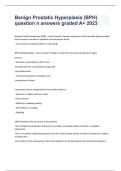
-
Benign Prostatic Hyperplasia (BPH) question n answers graded A+ 2023/2024
- Exam (elaborations) • 9 pages • 2024
- Available in package deal
-
- $14.99
- + learn more
Benign Prostatic Hyperplasia (BPH) question n answers graded A+ 2023Benign Prostatic Hyperplasia (BPH) - correct answer a benign enlargement of the prostate gland resulting from increase in number of epithelial cells and stream tissue. -most common urologic problem in male adults BPH Pathophysiology - correct answer Though to result from hormonal changes from aging process: -Excessive accumulation of DHT in the prostate cells that can stimulate overgrowth of prostate tissue -In...

-
Exam 2: NUR2063/ NUR 2063 (Latest 2024/ 2025 Update) Pathophysiology | Review with Questions and Verified Answers| 100% Correct| Grade A- Rasmussen
- Exam (elaborations) • 46 pages • 2024
- Available in package deal
-
- $11.99
- + learn more
Exam 2: NUR2063/ NUR 2063 (Latest 2024/ 2025 Update) Pathophysiology | Review with Questions and Verified Answers| 100% Correct| Grade A- Rasmussen Q: What type of incontinence is caused by an increase in intra abdominal pressure due to activities such as coughing or sneezing Answer: Stress incontinence Q: The client diagnosed with cystitis asks the healthcare provider why she seems susceptible to recurrent infections. What are most cases caused by?- Answer: Most cases ar...
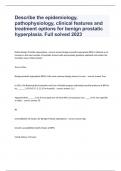
-
Describe the epidemiology, pathophysiology, clinical features and treatment options for benign prostatic hyperplasia. Full solved 2023(updated)
- Exam (elaborations) • 11 pages • 2024
- Available in package deal
-
- $13.49
- + learn more
Describe the epidemiology, pathophysiology, clinical features and treatment options for benign prostatic hyperplasia. Full solved 2023(updated)Describe the epidemiology, pathophysiology, clinical features and treatment options for benign prostatic hyperplasia. Full solved 2023 Define Benign Prostatic Hyperplasia - correct answer Benign prostatic hyperplasia (BPH) is defined as an increase in the total number of prostatic stromal cells and prostatic glandular epithelial cells within the tr...
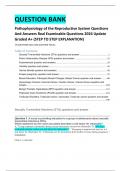
-
Pathophysiology of the Reproductive System Questions And Answers Real Examinable Questions 2024 Update Graded A+ (STEP TO STEP EXPLANATION)
- Exam (elaborations) • 160 pages • 2023
- Available in package deal
-
- $14.49
- + learn more
Pathophysiology of the Reproductive System Questions And Answers Real Examinable Questions 2024 Update Graded A+ (STEP TO STEP EXPLANATION) Sexually Transmitted Infections (STIs) questions and answer 1 Pelvic Inflammatory Disease (PID) question and answer 15 Endometriosis question and answers 29 Infertility question and answer 43 Uterine fibroids question and answers 58 Ectopic pregnancy question and answer 73 Breast Disorders: Fibrocystic Breast Changes, Breast Cancer question and answe...
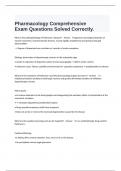
-
Pharmacology Comprehensive Exam Questions Solved Correctly.
- Exam (elaborations) • 44 pages • 2024
- Available in package deal
-
- $10.19
- + learn more
What is the pathophysiology of Parkinson's Disease? - Answer Progressive neurological disorder of muscle movement, characterized by tremors, muscle rigidity, bradykinesia and postural and gait abnormalities --> Degree of dopamine loss correlates w/ severity of motor symptoms Etiology: destruction of dopaminergic neurons in the substantia nigra • results in reduction of dopamine action in brain basal ganglia → affects motor control • Unknown cause: Theory- partially environme...
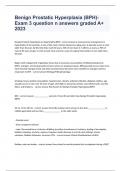
-
Benign Prostatic Hyperplasia (BPH)- Exam 3 question n answers graded A+ 2023/2024
- Exam (elaborations) • 9 pages • 2024
- Available in package deal
-
- $15.49
- + learn more
Benign Prostatic Hyperplasia (BPH)- Exam 3 question n answers graded A+ 2023 Benign Prostatic Hyperplasia or Hypertrophy (BPH) - correct answer A noncancerous enlargement or hypertrophy of the prostate, is one of the most common diseases in aging men. It typically occurs in men older than 40 years. By the time they reach 60 years, 50% of men have it. It affects as many as 90% of men by 85 years of age. It is the second most common cause of surgical intervention in men older than 60 years. Be...
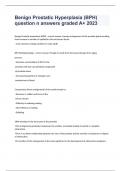
-
Benign Prostatic Hyperplasia (BPH) question and answers already passed
- Exam (elaborations) • 9 pages • 2024
- Available in package deal
-
- $13.49
- + learn more
Benign Prostatic Hyperplasia (BPH) question and answers already passed Benign Prostatic Hyperplasia (BPH) - correct answer a benign enlargement of the prostate gland resulting from increase in number of epithelial cells and stream tissue. -most common urologic problem in male adults BPH Pathophysiology - correct answer Though to result from hormonal changes from aging process: -Excessive accumulation of DHT in the prostate cells that can stimulate overgrowth of prostate tissue ...
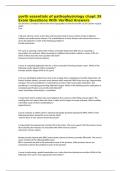
-
porth essentials of pathophysiology chapt 39 Exam Questions With Verified Answers
- Exam (elaborations) • 9 pages • 2024
-
- $10.59
- + learn more
porth essentials of pathophysiology chapt 39 Exam Questions With Verified Answers Circumcision is avoided in infants who have hypospadias so that the foreskin can be used for surgical repair. True A 60-year-old man comes to the clinic and has been found to have a history of type 2 diabetes mellitus and cardiovascular disease. The manifestations of these diseases will warrant the nurse to assess the patient for which of the following problems? Erectile dysfunction The nurse is asse...
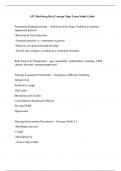
-
ATI Med-Surg Hesi Concept Map Exam Study Guide
- Exam (elaborations) • 41 pages • 2023
-
- $12.00
- + learn more
Pneumonia Pathophysiology - -Infection of the lungs. Problem in immunesuppressed patients. -Bacterial & Viral infections - hospital-acquired vs. community-acquired -Infection can spread throughout lungs. -Alveoli may collapse, resulting in a ventilation disorder. Risk Factors for Pneumonia - -age, immobility, malnutrition, smoking, URTI, chronic diseases, immunosuppressed Nursing Assessment Pneumonia - Tachypnea/ difficulty breathing Abrupt fever Productive cough Chest pain Bronchial ...
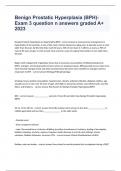
-
Benign Prostatic Hyperplasia (BPH)- Exam 3 Questions with complete solution 2024
- Exam (elaborations) • 9 pages • 2024
- Available in package deal
-
- $13.49
- + learn more
Benign Prostatic Hyperplasia (BPH)- Exam 3 Questions with complete solution 2024 Benign Prostatic Hyperplasia or Hypertrophy (BPH) - correct answer A noncancerous enlargement or hypertrophy of the prostate, is one of the most common diseases in aging men. It typically occurs in men older than 40 years. By the time they reach 60 years, 50% of men have it. It affects as many as 90% of men by 85 years of age. It is the second most common cause of surgical intervention in men older than 60 years. ...

Do you wonder why so many students wear nice clothes, have money to spare and enjoy tons of free time? Well, they sell on Stuvia! Imagine your study notes being downloaded a dozen times for $15 each. Every. Single. Day. Discover all about earning on Stuvia


